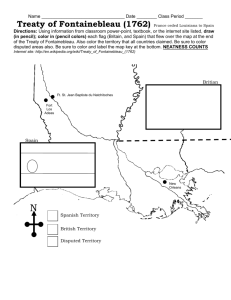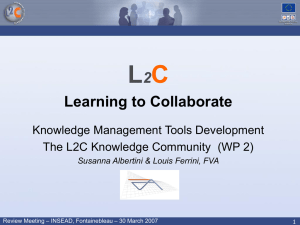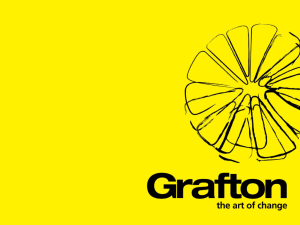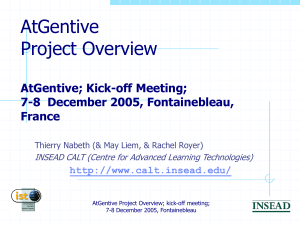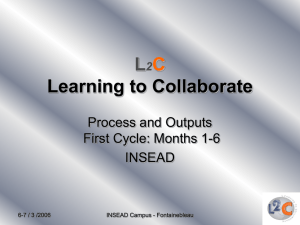L C 2 Learning to Collaborate
advertisement
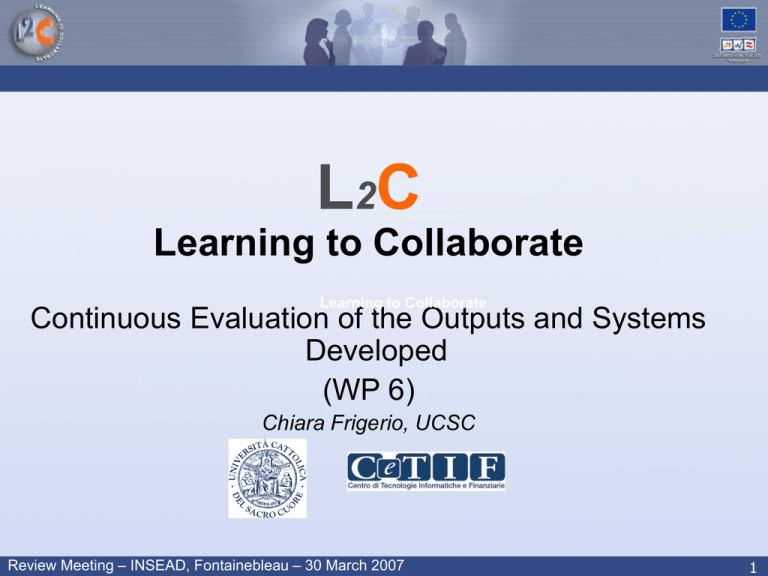
L 2C Learning to Collaborate Learning to Collaborate Continuous Evaluation of the Outputs and Systems Developed (WP 6) Chiara Frigerio, UCSC Review Meeting – INSEAD, Fontainebleau – 30 March 2007 1 Structure of the Presentation 1. The Evaluation Process 2. First Round Evaluation a. The Knowledge Community Evaluation b. The Prototypes’ Evaluation 3. Evaluation Process: Next Steps Review Meeting – INSEAD, Fontainebleau – 30 March 2007 2 Evaluation Process Objectives 1. 2. 3. 4. Guide continuous improvements to the development of outputs of the project, including testing and validating their effectiveness for the users. Represent a good indicator of performance, whereby the identification of challenges and needs can be used to improve potential future opportunities of collaboration. Represent the criteria for quality assurance of the outputs, verifying also accomplishment of goals. Provide assessment of the partners’ effort invested in the processes of innovation and new knowledge creation for gauging the value and effectiveness of their efforts. Review Meeting – INSEAD, Fontainebleau – 30 March 2007 3 Output to be evaluated WORKPACKAGE EXPECTED OUTPUT 1 – Knowledge Harvesting and Integration A comprehensive and integrated collection of collaboration-related dynamics, models and insights derived from a process of literature review. 2 – ACDT Knowledge Management Tools Development A structured knowledge base (knowledge management tool) A virtual learning community 3 – ACDT Framework and Simulation Games Prototype Development Framework adapted to the design, development and deployment of simulations First version of a simulation game 4 – Pilots Final release version of each one of the IT-based tools developed in Workpackages 2 and 3, as improved based on the feedback obtained from the pilots and prototyping cycles applied Review Meeting – INSEAD, Fontainebleau – 30 March 2007 4 The Evaluators • • • • • L2C Project partners, who care about the innovation being introduced and about its effectiveness because of the efforts invested. Target users of the project outputs, who represent the intended beneficiaries and users of the research findings. Potential future buyers of the projects outputs, who have an interest on the project’s success in delivering intended results (for examples, organizations or people whose opinion on the output is essential for its adoption in an organizational context). Strategic partners whose feedback in terms of knowledge is essential for the project improvements (for example, practitioners or scientists with expert knowledge on a specific topic). The European Community, which will provide independent evaluators and reviewers to assess the project’s outputs. Review Meeting – INSEAD, Fontainebleau – 30 March 2007 5 Evaluation Methodology The main reference for this project is the Goal Question Metric (GQM) approach by Basili and Weiss (1984). This framework is based on the assumption that to measure a project’s effectiveness in a purposeful way it is essential to first specify the goals to be accomplished. Review Meeting – INSEAD, Fontainebleau – 30 March 2007 6 Evaluation Framework/1 Level of investigation Purpose Conceptual Each goal aims at identifying the issue or viewpoint to be evaluated. It has three main coordinates: Object: what is being analysed Issue: the object’s property to be analysed Viewpoint: who uses the collected feedback Purpose: why is the object analysed CRITERIA (OR QUESTIONS ASKED) Operational Each criterion represents a refinement of the goal it refers to, adopting an operational perspective. This allows a better interpretation and description of the conceptual issue. METRICS Measurement Set of objective or subjective data associated with every question, in order to answer it in a quantitative and measurable way. GOALS To illustrate: Suppose one of the main objectives/goals of the Knowledge Community is to be usable. In this case, suitable criterion and metrics to be presented would be: • How intuitive is it for a user to find a contribution? 1(=very intuitive) to 5 (=not intuitive at all)? • How understandable understandable are the menus? 1(=very understandable) to 5 (=not understandable at all). Review Meeting – INSEAD, Fontainebleau – 30 March 2007 7 Evaluation Framework/2 WORKPACKAGE GUIDELINES FOR IDENTIFYING EVALUATION CRITERIA • 1 – Knowledge Harvesting and Integration 2 – ACDT Knowledge Management Tools Development 3 – ACDT Framework and Simulation Games Prototype Development • The body of knowledge collected supports effective development of the successive workpackages, i.e. operationalizable. The output of WP 1 provides guidelines for added value creation of the IT-based tools facilitating collaborative practices. The structure, interface and features of the Knowledge Management Tools are designed to: • Fit the know-how collected in WP1 • Facilitate access to the know-how stored • Facilitate restructuring of the knowledge base • Facilitate new contributions • Facilitate connections among members • Facilitate active participation among members • • • • • • 4 – Pilots • The ACDT framework supports the creation of effective collaboration-related simulations (in terms of providing an array of scenarios, characters, dynamics, interventions, etc). The game meets its objectives of addressing advanced collaboration dynamics. The game is innovative and improves on existing learning solutions. The simulation pilots consider realistic scenarios of collaboration. The pilots address important collaboration-related dynamics, breakdowns and interventions. In the second version of the ACDT Knowledge Base and Virtual Learning Community, re-design and extensions have been made to expand the access of the tools to a more heterogeneous population (those not part of theL2C Consortium). Feedback from the evaluation loops has been implemented to ensure the tools developed are effective and sustainable beyond the duration of the project. Review Meeting – INSEAD, Fontainebleau – 30 March 2007 8 Evaluation Perspectives The evaluation of the IT-based tools will be conducted along two dimensions. • A technical/technological perspective which will investigate ITrelated dimensions such as usability, functionalities, security and effectiveness of the tools. • A pedagogical and social perspective which focuses on factors such as value to and level of acceptance by the users. Users represent relevant actors who will contribute to continuous improvement of the outputs and will also provide final feedback on the quality and learning value of the tools. Review Meeting – INSEAD, Fontainebleau – 30 March 2007 9 Overall Evaluation Process Review Meeting – INSEAD, Fontainebleau – 30 March 2007 10 Overall Evaluation Approach FORMATIVE EVALUATION SUMMATIVE EVALUATION Knowledge Harvesting State of the Art Report STRATEGIC EVALUATION • Questionnaire ACDT Framework • Questionnaire ACDT Dynamic Knowledge Base • Questionnaire • Focus group • Questionnaire • Log analysis ACDT Virtual Learning Community • Questionnaire • Focus group • Questionnaire • Log analysis • Questionnaire ACDT Simulation Game • Think aloud method • Focus group Review Meeting – INSEAD, Fontainebleau – 30 March 2007 • Questionnaire • Interviews Q u e s t i o n n a i r e 11 Deadlines WORKPACKAGE PROJECT’S MONTH OF EXPECTED SUMMATIVE EVALUATION DATE OF EXPECTED SUMMATIVE EVALUATION Evaluation of Workpackage 1 (Knowledge Harvesting material as represented in the KB and ACDT Framework) Month 14 February 2007 Evaluation of Workpackage 2 (Knowledge Management Tool and Virtual Community) Month 12 February 2007 Evaluation of Workpackage 3 (Game Prototype and validity of ACDT Framework) Month 14 April 2007 Evaluation of Workpackage 4 (Pilots) Month 23 January 2008 Strategic evaluation Month 23 January 2008 Review Meeting – INSEAD, Fontainebleau – 30 March 2007 12 Expected Deliverables DELIVERABLE DATE OF EXPECTED DELIVERY D 6.1 Evaluation Plan Done D 6.2 Technical and Pedagogical Evaluation Criteria and Metrics Done D 6.3 Evaluation Report of the First Prototype Done D 6.4 Evaluation Report of the Final Prototype Month 18 D 6.5 Evaluation Report of Simulation Games prototypes Month 22 D 6.6 Project’s Assessment / Comparative Analysis (Final Report) Month 24 Review Meeting – INSEAD, Fontainebleau – 30 March 2007 13 Structure of the Presentation 1. The Evaluation Process 2. First Round Evaluation a. The Knowledge Community Evaluation b. The Prototypes’ Evaluation 3. Evaluation Process: Next Steps Review Meeting – INSEAD, Fontainebleau – 30 March 2007 14 Deliverable 6.3 D6.3 provides the formative assessment of the first version of the following outputs: • The ACDT Knowledge Management Tools from technical/technological perspective (from Workpackage 2) – Period of evaluation: February 2006. • The evaluation of the specification of the first version of the ACDT Simulation Games Prototypes, from a pedagogical point of view as presented in D3.1 “ACDT Framework, Simulation Scenarios and Design” (from Workpackage 3) – Period of evaluation: February 2006. Review Meeting – INSEAD, Fontainebleau – 30 March 2007 15 Structure of the Presentation 1. The Evaluation Process 2. First Round Evaluation a. The Knowledge Community Evaluation b. The Prototypes’ Evaluation 3. Evaluation Process: Next Steps Review Meeting – INSEAD, Fontainebleau – 30 March 2007 16 The Knowledge Community Evaluation/1 WHAT: first prototype of the system (programming errors, technical problems, usability and navigation issues) WHEN: August 2006 WHO: pool of experts comprised of FVA and INSEAD internal usability experts and usability free-lance experts hired by FVA HOW: report of tickets, usability protocol submission and thinkaloud method Review Meeting – INSEAD, Fontainebleau – 30 March 2007 17 The Knowledge Community Evaluation/2 WHAT: first prototype of the system after technical improvements WHEN: September 2006, 2nd Consortium meeting in Milan WHO: L2C Consortium partners HOW: informal suggestions and brainstorming Review Meeting – INSEAD, Fontainebleau – 30 March 2007 18 The Knowledge Community Evaluation/3 WHAT: first formal assessment on the technical/technological features and functionalities WHEN: February 2007, after a one month period of usage WHO: by the Consortium partners HOW: questionnaire composed of 44 questions in total, among which 5 were open questions, 26 were questions based on Likert scale answers and 13 were yes/no questions. Review Meeting – INSEAD, Fontainebleau – 30 March 2007 19 System Features Evaluated Virtual Learning Community Knowledge Community Knowledge Base Usability X X Simplicity and Clarity X X X Orientation and Navigation X X X Learnability X Effective Communication X Text Layout X User Control and Freedom X Interface X X X System Features Completeness Review Meeting – INSEAD, Fontainebleau – 30 March 2007 20 The Knowledge Community: Qualitative Evaluation A number of areas were identified for improvement, especially making the community functions easier to use for members who do not belong to the L2C network. The following are the main features which need to be improved: • • • • • • The left menu, which right now imposes a long scrolling down to various sources of information makes the home or main page appear too overloaded with information. A more selective way to filter and present relevant information is needed. Some online instructions for new users who will not be familiar with the purpose and logic of the L2C project. First impression management is important. The contributions’ editing functionality. A layout or interface which uses more contrasting and intense colors. Additional search and better organization functions, since the contents of the knowledge community will increase over time. Some additional collaboration tools in the virtual community area could be inserted to provide easy to use and accessible communication and collaboration opportunities. Review Meeting – INSEAD, Fontainebleau – 30 March 2007 21 Knowledge Community Overview The assessment of the Knowledge Community shows that in general the partners are satisfied with the tool and its functionalities. According to their opinions, this is a good starting point since the community has the relevant collaboration tools, it is pretty intuitive, and simple to be used. The suggestions and feedback provided will be used to drive future improvements to the knowledge community from a technical point of view. They will be discussed among partners to decide on how to best address each specific issue, and in particular, to determine a list of priorities. Review Meeting – INSEAD, Fontainebleau – 30 March 2007 22 Structure of the Presentation 1. The Evaluation Process 2. First Round Evaluation a. The Knowledge Community Evaluation b. The Prototypes’ Evaluation 3. Evaluation Process: Next Steps Review Meeting – INSEAD, Fontainebleau – 30 March 2007 23 The Prototypes Evaluation WHAT: version 1 of each of the simulation games prototypes WHEN: February 2007 WHO: by the Consortium partners, based on their expertise and interest, as determined during the 3rd Consortium meeting in Athens in January 2007. HOW: questionnaire composed of 15 questions in total, among which 1 was an open-ended question and 14 were questions using Likert scale answers. Additionally, 6 of the 15 questions were intended to evaluate the prototypes in general, while the other 9 assessed specific dimensions of each prototype. Review Meeting – INSEAD, Fontainebleau – 30 March 2007 24 EduSynergy The overall assessment has showed that the EduSynergy prototype presents a learning experience which provides players an opportunity to come into contact with a number of collaboration challenges and dynamics at an organizational level. However, there are still are some dimensions which need to be clarified and improved: • Transferability of the Edusynergy scenario to a wider, nonUniversity/academic audience • The need to fine-tune the collaboration focus of the simulation • Addressing the complexities of intra-organizational collaboration • Realism of the player role Review Meeting – INSEAD, Fontainebleau – 30 March 2007 25 World Team The overall assessment indicates that the World Team prototype presents detailed key learning points, which consider all organisational, group and personal dynamics. Areas of improvement would be: • Acquisition strategy familiarity • Further developments to the scenario • Inclusion of a performance indicator to track progress • Reccomandation for controlling communication opportunities within the simulation Review Meeting – INSEAD, Fontainebleau – 30 March 2007 26 Pit Stop The overall assessment has showed that the Pit Stop design specification is well described and detailed. It provides a good starting experience for discussing distinctive individual and team behaviours and competences for high performing teams, and to extend the discussion to team practices and performance within each participant’s organization/division. The suggestions for improvement refer to: • Emphasis on the time factor • Qualification of key learning points • More emphasis on the theories on stress management Review Meeting – INSEAD, Fontainebleau – 30 March 2007 27 Eagle Racing The overall assessment has showed that the Eagle Racing prototype is well described and addresses interesting challenges. Further improvements should consider the following suggestions: • Prioritizing long list of learning points • Taking into account the complexity of decision making process and goals • Avoid extreme stereotypes Review Meeting – INSEAD, Fontainebleau – 30 March 2007 28 Intermediary Agent The overall assessment has showed that the Intermediary Agent prototype is quite good described, but still there are some opportunities of improvement concerning the following: • Identity of the intermediary agent • Information asymmetry • Change and collaboration dynamics Review Meeting – INSEAD, Fontainebleau – 30 March 2007 29 Overall Assessment of The Five Prototypes The prototypes address a broad spectrum of models, collaborative breakdowns etc. However in some places it is necessary to make further specifications, as suggested by the partners and concerning the following: • Need for an overall model of learning objectives • Identification of “top” theories All the improvements previously suggested will be validated with partners during the piloting phase, Workpackage 4. Review Meeting – INSEAD, Fontainebleau – 30 March 2007 30 Structure of the Presentation 1. The Evaluation Process 2. First Round Evaluation a. The Knowledge Community Evaluation b. The Prototypes’ Evaluation 3. Evaluation Process: Next Steps Review Meeting – INSEAD, Fontainebleau – 30 March 2007 31 Evaluation Process: upcoming activities • • • • • Summative pedagogical evaluation of the Knowledge Community (final users) Summative technological evaluation of the Knowledge Community (after improvements from first round evaluation) Pedagogical evaluation of the final simulation prototypes (partners) Formative technical evaluation of the final simulation prototypes (technical experts and eventually partners) The possibility to perform the proposed evaluation activities depends on the WPs progress. Review Meeting – INSEAD, Fontainebleau – 30 March 2007 32
